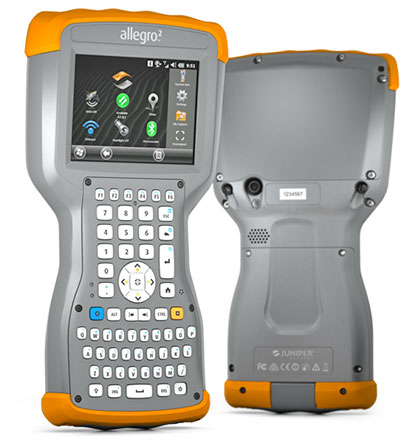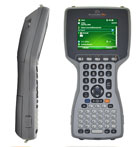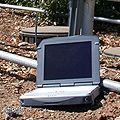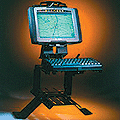|
Juniper Allegro 2 Rugged Handheld
Next gen of data-intensive handheld builds on the reliability of its predecessor, but gets technology updates and adds major advancements
(by Conrad H. Blickenstorfer)
On October 9, 2014, Juniper Systems of Logan, Utah, introduced the Allegro 2 rugged handheld computer as a follow-up (and eventual replacement) of the company's longtime workhorse, the Allegro MX Field PC. The Allegro 2, the company says, incorporates "every bit of the reliability" of the Allegro MX, "but now with some major advancements." So what advancements is Juniper talking about, and what do they mean to customers?

Let's say right upfront that it's not easy to improve a product like the Allegro. It's a time-tested design that has been around for many years, one that was created to fit into big hands even with thick gloves on, one with a big keypad with all the necessary keys to add data in the field, one with a big battery, and one with enough configuration and customization potential to fit many jobs. None of that needed to be changed; it never goes out of style. But technology moves on, and it was time for a refersh. Not a drastic one, that wasn't needed. But Juniper sent the Allegro for a make-over and it came back with a sleek modern look and and it learned a bunch of new tricks. So below are the Cliffs Notes of what's new in the Allegro 2:
|
Juniper Systems Allegro 2 vs. original Allegro
|
|
Model
|
Allegro 2
|
Allegro
|
|
|

|

|
|
Introduced
|
2014
|
2009
|
|
OS: Windows
|
Embedded Handheld 6.5.3
|
Mobile Classic 6.1
|
|
Processor
|
1.0GHz Freescale i.MX53
|
624MHz Marvell PXA270
|
|
RAM/ROM
|
512MB/8GB
|
128MB/1/2GB
|
|
Expansion slots
|
micro SD/SDHC
|
PC Card + micro SD/SDHC
|
|
Display
|
4.2"/640 x 480 pixel
|
3.8"/320 x 240 pixel
|
|
Digitizer
|
Projected capacitive
|
Resistive
|
|
Battery
|
38.7 watt-hour Li-Ion
|
14.4 watt-hour NiMH
|
|
Battery Life
|
up to 20 hrs.
|
8-10 hrs.
|
|
Keypad
|
64-key QWERTY + numeric
|
63-key Alpha + numeric
|
|
Keypad backlight
|
Yes
|
No
|
|
Size (inches)
|
5.4 x 10.2 x 1.6
|
5.25 x 10.0 x 1.5
|
|
Weight (lb.)
|
2.0
|
1.8
|
|
Sealing
|
IP68 (dustproof and totally waterproof)
|
IP67 (dustproof and limited immersion)
|
|
Temp. range
|
-22° to 140°
|
-22° to 130°
|
|
Camera
|
5mp rear (opt.)
|
not available
|
|
Audio
|
Speaker + mic.
|
not available
|
|
Compass
|
Yes
|
No
|
|
Accelerometer
|
Yes
|
No
|
|
USB
|
Full-size + micro
|
Full-size + mini
|
|
Bluetooth
|
v2.1 Class 1.5 (100+ ft)
|
v2.0 Class 1 (65 ft)
|
|
WiFi
|
Integrated 802.11b/g/n
|
802.11b/g (required card)
|
|
WWAN
|
3.75G, HSPA+/UMTS
|
not available
|
|
GNSS/GPS
|
"significantly enhanced"
|
via pod option
|
And here's some commentary on what's changed and why it matters:
- The screen now measures 4.2 inches diagonally instead of 3.8 inches. By our reckoning, that's 25% more screen real estate. And the new display's 640 x 480 resolution quadruples the number of pixels of the original Allegro. That means much more detail and a much sharper display. There's also Juniper's "Sun-to-Shade" display technology that the company says makes it "easy to view in both glaring sunlight and shady conditions." It's a custom transflective design. A larger, brighter and sharper screen is always good news.
- There's now projected capacitive touch, the kind hundreds of millions of users are familiar with from their smartphones. But Juniper's version can also be used with gloves on. Which comes in very handy out there in the field where it can get cold and wet. The surface is also extremely scratch-resistant, and the new Allegro comes with a special capacitive stylus (which also works with gloves on).
- The new i.MX53 processor (see product sheet), made by Freescale (which was spun off Motorola in 2004), runs at a 60% higher clock speed than the one in the Allegro MX. More speed is always good, and it's intriguing that this processor is able to run Android as well. Juniper says an Android version of the new Allegro is possible.
- With virtually everyone adept at texting these days, Juniper gave the Allegro 2 a newly-designed QWERTY + numeric keyboard for even quicker and more intuitive data entry. There are now six user-assignable function keys that can perform a total of 12 functions.
- The original Allegro was extremely tough, but the new Allegro 2 is tougher yet. For ingress protection, it now rates an almost unbelievable IP68. The first number stands for protection against solids. 6 is as high as it gets, and it means the unit is totally protected against the finest dust. The second number is for the degree of protection from liquids. That scale goes from 0 (no protection) to 8 (totally immune to water, even indefinite immersion). So the 8 means the device is protected against the long periods of immersion under pressure. And the operating temperature range is now even wider, all the way up to a baking 140 degrees Fahrenheit.
- It includes a lot of new improved technology. Among available options, WiFi is faster, Bluetooth is faster and has a longer range, and there's now a 5mp camera. RAM and Flash memory have both been quadrupled, there's a speaker and a microphone, and Juniper says GNSS performance is significantly enhanced, with sub-meter accuracy when post-processed. An external GPS antenna kit is planned.
- The switch from NiMH to Li-Ion allowed a much more powerful battery that more than doubles the estimated battery life. It's up to 20 hours now. The new battery (which is the same as that used in the Archer 2) also has fast-charge capability and a longer lifespan. Juniper has always known the value of a beefy battery that won't conk out when you most need it.
- Despite the larger screen and the additional protection, and the much more powerful battery, the new model is only a little larger and heavier than the old one. And Juniper says the new Allegro actually floats!
- The original Allegro provided additional functionality via expansion pods that use the unit's internal PC Card slot. The new one no longer has a PC Card interface because functionality that only used to be available via expansion pods in the previous Allegro is now available via integrated options. Note that the new Allegro 2 is available in a GEO version with camera and GPS/GNSS, and a GEO CELL version with camera, GPS, and integrated 3.75G GSM modem.
- The developer expansion area allocated for third party add-ons and functionaliy area has been doubled in size.
- While retaining dimensions, weight and overall design, the Allegro 2 now sports the attractive light-gray/orange color scheme that we have come to associate with Juniper rugged field computing hardware. As is the case with the Archer 2, gray bumper trim will be available as well.

The new Allegro 2 remains an exceptionally well connected device. In an era where handhelds and smartphones often just contain a proprietary port or a micro-USB port, the new Allegro still has a standard DB9 RS232 serial port, a full-size standard USB port, and a full-size 3.5mm audio jack. What's more, the I/O module is configurable, customizable, and also user-replaceable.
The new Allegro 2
Designing mobile computing technology for the field is a lot more difficult than it used to be. The smartphone and tablet revolution of recent years has forever changed consumer expectations. Meeting those expectations while still providing the basic nuts and bolts of what's needed in the field—ruggedness, legacy support, leverage, compatibility, etc.—is a challenge where erring on one side or the other can make quite a difference.
Juniper Systems calls their new Allegro 2 a device "designed for the data-intensive." It was always that, and now it's even more so, with extra speed, extra memory, fine-tuned ergonomics, a better display, a better user interface, and much longer battery life. Once again, Juniper has changed one of its signature rugged handhelds not for change's sake, but to make even better what was already very good.
|
|
 Specifications Juniper Allegro 2 Specifications Juniper Allegro 2
|
|
Status
|
Added 10/2014
|
|
Form-factor
|
Rugged Handheld
|
CPU
|
1GHz Freescale i.MX53 ARM Cortex A8
|
OS
|
Windows Embedded Handheld 6.5.3
|
RAM/ROM
|
512MB RAM/8GB Flash |
Card slots
|
1 micro SD/SDHC, 1 x SIM
|
Display type
|
High visibility "Sun-to-Shade" backlit color TFT with strengthened glass
|
Display size/res
|
4.2"/640 x 480 pixel VGA
|
Digitizer/pens
|
Projected capacitive touch, glove-friendly, scratch-resistant
|
Keyboard/keys
|
64-key numeric keypad with user-assignable keys with adjustable backlight
|
Navigation
|
Touch, navigation keys
|
Housing
|
Hardened plastic, impact-absorbing bumpers, strong chemical resistance
|
Operating Temp
|
-22° to 140°F (-30°; to 60°C)
|
Sealing
|
IP68
|
Shock
|
MIL-STD 810G 516.6 -- Multiple 4-foot drops to concrete
|
Vibration
|
MIL-STD 810G 514.6
|
Altitude
|
MIL-STD 810G 500.5
|
Humidity
|
MIL-STD 810G 507.5
|
Size (WxHxD)
|
5.4 x 10.2 x 1.6 inches (138 x 256 x 40 mm)
|
Weight
|
2 lbs. (908 g) w/ battery
|
Power
|
3.7V 10,600mAH 38.7 watt-hour ("up to 20 hrs")
|
Camera
|
5mp AF with LED illuminator and geotagging (GEO models only)
|
GPS
|
32-channel GPS/GLONASS/SBAS w/ 2 meter accuracy (GEO models only)
|
Scanner
|
NA
|
Interface
|
1 x USB host, 1 x USB client Micro B, 1 x RS232 DB9, 3.5mm audio jack (I/O module is customizable)
|
Wireless
|
Options: Class 1.5 Bluetooth 2.1 + EDR, WiFi 802.11b/g/n, 3.75G WWAN, HSPA+/UMTS
|
Certifications
|
FCC Class B, CE, Industry Canada, EN60950 Safety
|
List price
|
Starting at US$2,695
|
Contact
|
www.junipersys.com
|
Web page
|
Allegro 2 web page
|
Specs
|
 Allegro 2 data sheet Allegro 2 data sheet
|
Specs
|
 Allegro 2 spec sheet Allegro 2 spec sheet
|
|
 Windows Mobile Info Windows Mobile Info
|
Windows 10 IoT Core
Windows Embedded 8.1 Handheld
Windows Embedded Compact 2013
Windows Embedded 8 Handheld
Windows Embedded Compact 7
Windows Embedded Handheld
Windows Phone 7
Windows Embedded CE 6.0 R3
Windows Mobile 6.5
Windows Mobile 6
Windows CE 6.0
Windows Mobile 5
Windows CE 5.0
Windows Mobile Smartphone
Windows Mobile 2003
Windows CE .Net
Windows for Pocket PC 2002
Pocket PC intro 2000
Windows CE H/PC Pro 1998
Windows CE 2.0 1997
|
 Juniper Allegro2 Juniper Allegro2
|

|
 Juniper Systems contact
Juniper Systems contact
|
|













